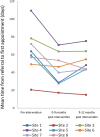Sustainable waiting time reductions after introducing the STAT model for access and triage: 12-month follow up of a stepped wedge cluster randomised controlled trial
- PMID: 33087110
- PMCID: PMC7579912
- DOI: 10.1186/s12913-020-05824-z
Sustainable waiting time reductions after introducing the STAT model for access and triage: 12-month follow up of a stepped wedge cluster randomised controlled trial
Abstract
Background: Timely access is a challenge for providers of outpatient and community-based health services, as seen by the often lengthy waiting lists to manage demand. The Specific Timely Appointments for Triage (STAT) model, an alternative approach for managing access and triage, reduced waiting time by 34% in a stepped wedge cluster randomised controlled trial involving 8 services and more than 3000 participants. Follow up periods ranged from 3 to 10 months across the participating services in accordance with the stepped wedge design. This study aimed to determine whether outcomes were sustained for a full 12 months after implementation of the STAT model at each site.
Methods: Routinely collected service data were obtained for a total of 12 months following implementation of the STAT model at each of the 8 services that participated in a stepped wedge cluster randomised controlled trial. The primary outcome was time to first appointment. Secondary outcomes included non-attendance rates, time to second appointment and service use over 12 weeks. Outcomes were compared to pre-intervention data from the original trial, modelled using generalised linear mixed effects models accounting for clustering of sites.
Results: A 29% reduction in waiting time could be attributed to STAT over 12 months, compared to 34% in the original trial. A reduction in variability in waiting time was sustained. There were no significant changes in time to second appointment or in the number of missed appointments in the extended follow up period.
Conclusions: STAT is an effective strategy for reducing waiting time in community-based outpatient services. At 12 months, small reductions in the overall effect are apparent, but reductions in variability are sustained, suggesting that people who previously waited the longest benefit most from the STAT model.
Trial registration: This is a 12-month follow up of a stepped wedge cluster randomised controlled trial that was registered with the Australia and New Zealand Clinical Trials Registry ( ACTRN12615001016527 ).
Keywords: Appointments and schedules; Community health; Outpatients; Triage; Waiting lists.
Conflict of interest statement
The authors declare that they have no competing interests.
Figures
Similar articles
-
Service-level interventions to reduce waiting time in outpatient and community health settings may be sustained: a systematic review.BMJ Open Qual. 2025 Mar 7;14(1):e003235. doi: 10.1136/bmjoq-2024-003235. BMJ Open Qual. 2025. PMID: 40054995 Free PMC article.
-
Improving access for community health and sub-acute outpatient services: protocol for a stepped wedge cluster randomised controlled trial.BMC Health Serv Res. 2016 Aug 9;16(a):364. doi: 10.1186/s12913-016-1611-3. BMC Health Serv Res. 2016. PMID: 27506923 Free PMC article. Clinical Trial.
-
A model of access combining triage with initial management reduced waiting time for community outpatient services: a stepped wedge cluster randomised controlled trial.BMC Med. 2018 Oct 19;16(1):182. doi: 10.1186/s12916-018-1170-z. BMC Med. 2018. PMID: 30336784 Free PMC article. Clinical Trial.
-
Staff perspectives of a model of access and triage for reducing waiting time in ambulatory services: a qualitative study.BMC Health Serv Res. 2019 May 3;19(1):283. doi: 10.1186/s12913-019-4123-0. BMC Health Serv Res. 2019. PMID: 31053118 Free PMC article.
-
[Waiting lists: case management and an alternative reimbursement paradigm].Ig Sanita Pubbl. 2003 Nov-Dec;59(6):393-412. Ig Sanita Pubbl. 2003. PMID: 15116151 Review. Italian.
Cited by
-
Return on investment of a model of access combining triage with initial management: an economic analysis.BMJ Open. 2021 Jul 21;11(7):e045096. doi: 10.1136/bmjopen-2020-045096. BMJ Open. 2021. PMID: 34290062 Free PMC article.
-
Sustainability of an intervention to reduce waiting for access to an epilepsy outpatient clinic.Heliyon. 2023 Dec 10;10(1):e23346. doi: 10.1016/j.heliyon.2023.e23346. eCollection 2024 Jan 15. Heliyon. 2023. PMID: 38169770 Free PMC article.
-
A Multi-Faceted Strategy for Evidence Translation Reduces Healthcare Waiting Time: A Mixed Methods Study Using the RE-AIM Framework.Front Rehabil Sci. 2021 Mar 23;2:638602. doi: 10.3389/fresc.2021.638602. eCollection 2021. Front Rehabil Sci. 2021. PMID: 36188815 Free PMC article.
-
Using artificial intelligence to reduce queuing time and improve satisfaction in pediatric outpatient service: A randomized clinical trial.Front Pediatr. 2022 Aug 10;10:929834. doi: 10.3389/fped.2022.929834. eCollection 2022. Front Pediatr. 2022. PMID: 36034568 Free PMC article.
-
Service-level interventions to reduce waiting time in outpatient and community health settings may be sustained: a systematic review.BMJ Open Qual. 2025 Mar 7;14(1):e003235. doi: 10.1136/bmjoq-2024-003235. BMJ Open Qual. 2025. PMID: 40054995 Free PMC article.
References
Publication types
MeSH terms
Grants and funding
LinkOut - more resources
Full Text Sources



